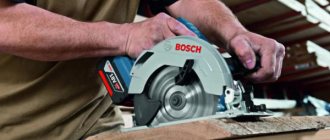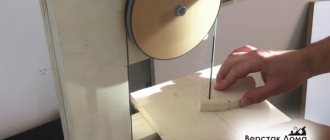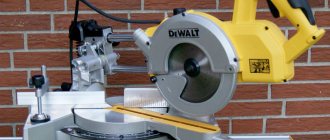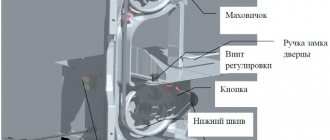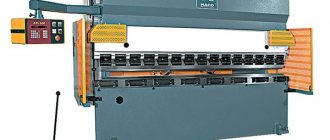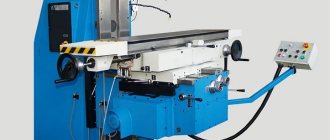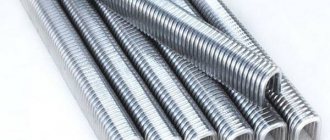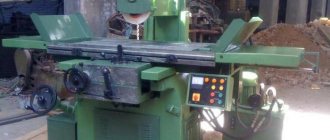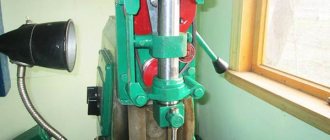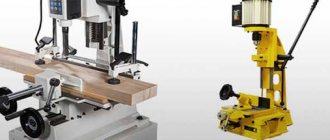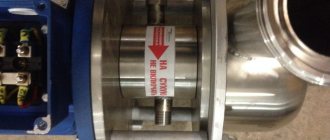A metal band saw, also known as a band saw, is a stationary tool used for straight and shaped cutting of metal parts. Due to its convenience and ease of operation, the equipment has become widespread both in large construction industries and when carrying out repair work at home or in the country. We will understand the features of working with the tool, as well as the process of making it yourself at home.
Design and technical parameters of a band saw
The main element of a band saw is the cutting blade, which has a closed shape. Its width is from 6 mm to 4 cm.
Types of saw blades:
- toothed;
- friction saw;
- electrospark.
The belt blade consists of teeth made of high-strength alloy steel. The tooth pitch (number of teeth per 1 inch) of the blade varies in the following ranges:
- for instruments with constant pitch: from 1 to 32;
- for equipment with variable pitch: from 10/14 to 0.75/1.25.
One of the most important characteristics of the device is the setting, which refers to the amount of inclination of the teeth to the plane of the blade. Using this parameter, the required travel of the blade and tooth edge is ensured.
There are four types of wiring:
- Standard - represents the classic combination of teeth (right, left, straight);
- right-left setting - alternating teeth turned to the right and left (used when processing soft metals);
- wave setting - a special type of setting, used for tools used to cut small-diameter workpieces;
- combined wiring - a type that combines elements, designed for sawing pipes and structures with variable cross-sections.
Other belt nodes:
- bed (frame) - necessary to give the tool stability and minimize vibration during operation;
- a work table on which a stop and a ruler are installed;
- two drive pulleys, the rotational movements of which drive the entire mechanism;
- engine (from 2 kW);
- device control panel;
- parts lubrication system;
- protective case.
The following metals are used in the production of band saw machines:
- carbon steel;
- spring steel;
- tool alloys;
- high speed steel;
- hard alloys.
The tool can be used for both wood processing and steel cutting.
Characteristics of a wood band saw
Main store models:
- "Cedar";
- "Master";
- "Taiga;
- "Altai".
Used for cutting large tree trunks and primary timber (for forestry work). The advantage over a circular saw is the small thickness of the cut (from 1.5 to 2.5 mm).
Characteristics of a metal band saw
Machines for sawing metal structures are used both for straight cutting of blanks and for shaped cutting of alloys.
The operating speed of the tool is from 30 to 100 m/min, depending on the type of metal and saw model. The table shows average indicators, which can fluctuate in the range of 10-15% depending on the type of saw blade.
| Metal type | Linear speed (m/min) | Coolant consumption (%) |
| Classic steel | 50-100 | 10 |
| Stainless metals | 30-40 | 5 |
| Tool steel | 40-70 | 10 |
| Rental | 20-25 | 5 |
| Bronze | 80-100 | 3 |
| Aluminum | 80-120 | 25 |
| Cast iron | 30-60 | — |
| Copper | 60-100 | 3 |
| Titanium | 15-25 | 10 |
In addition to hard alloys, the machines can process parts made of foam and plastic.
Types of band saws by purpose
The design and materials of manufacture differ depending on the purpose for which the equipment is intended. In general, such machines can be divided into 3 types:
- On wood.
- For metal.
- For meat and bones.
A wood saw is designed for cutting and cutting wood. This can be either previously prepared lumber or tree trunks. A metal cutting machine usually has smaller dimensions. It is designed for cutting and cutting metal workpieces. The meat and bone band saw is used for cutting up pork and cattle carcasses. The difference between this type of machine is the use of food grade steel and plastics for its production.
Classification of band saws
According to their design features, band saws are:
- Cantilever (pendulum) band saw - in its manufacture, a special saw console is used, which rises and falls due to the rotational actions of the hinge. This type is used for sawing stainless steel pipes, prepackaged profiles, and rolled products.
- Single-post - they are based on a horizontal saw frame that descends along a vertical post. Its design parameters are similar to a radial drilling machine. The main advantage of this type is the ability to cut metal products at an angle.
- Two-post saws also use a horizontal saw frame that moves along 2 vertical columns. The connection to the frame is made using a rigid closed loop. The advantage of two-post saws is considered to be high levels of competition; the tool can be used for cutting any metal.
- Portal machines - consist of a fixed working area and a movable portal for cutting, on which it is possible to process materials of large dimensions (plates, castings). The advantage of the tool is its compactness: since the portal moves along the linear guides of the desktop, the equipment does not require much free space.
- Vertical band saw for metal - designed for both straight and curved cutting along external and external contours. Operating principle: the workpiece is not clamped in a vice, but is held in the working area manually.
- Rotary (angular) - allow you to cut metal at different angles to the axis of the part. Their design is based on a rotary saw frame rotating around a vertical axis. This allows you to adjust the cutting angle in one movement.
By degree of automation
- Manual (gravity) - the saw frame is driven by the use of the worker’s physical strength, as well as its own weight.
| Advantages | Flaws |
| 1. Price-quality ratio (low cost of equipment with high performance of the tool). 2. Possibility of adjusting the cutting angle (up to 60°). | 1. Significant vibration during operation, which leads to rapid wear of the equipment. 2. Lack of reliable automatic cleaning mechanisms. 3. The need for manual control of the pulley tilt level. 4. Lack of automatic control of the pressure force of the equipment on the workpiece. |
- Semi-automatic saws - all operations (clamping and opening the vice, lowering and raising the saw blade) are carried out automatically using a hydraulic drive. The worker's task is only to control the movement of metal. Processing of products is possible at an angle from -60° to +60°. Suitable for cutting heavy metals, including solid cast iron, non-ferrous alloys, and stainless steel.
- Automatic metal band saw - used in large industrial production. The operator's tasks are minimal: he only needs to set the metal processing parameters when placing the workpiece in a vice. The further process is automated, the sawing process is controlled by CNC. The equipment is characterized by the highest productivity, as well as high levels of accuracy.
By functional features
- Class I - saws are used in large industrial production for processing any type of metal (metallurgical plants, production shops, heavy engineering, etc.). The width of the canvas is at least 27 mm. The cutting surfaces are characterized by high strength, which ensures low wear rates and low cost per cut.
- Class II is a popular type of band saw. They are used in the procurement production of mechanical engineering enterprises for cutting non-ferrous metals, alloy steel, heat-resistant alloys, and titanium. The width of the tape web is from 20 mm.
- Class III - most often represented by console saws. They are used in small industries producing pipes and rolled profiles. A tool with low productivity and high tooth wear. The width of the canvas is from 17 mm.
- Class IV - small-sized, lightweight devices used for cutting parts whose diameter does not exceed 50 mm. Class IV band saws are not used in industrial production. They are in demand in repair shops and for private use. The width of the canvas does not exceed 13-15 mm.
Types of band saws
The following types of band saws are distinguished: • toothed saws • toothless friction saws • electric spark action. Unlike hacksaw blades, serrated band saws are made in a closed loop. Band saws with teeth are used for sawing and cutting any materials, including metal, wood, foam concrete and other building materials.
Toothless friction and electric spark band saws have a principle of operation similar to the operation of friction circular saws. However, the purpose of the teeth in friction band saws is different from the purpose of the teeth in circular saws and electric spark action.
When choosing a band saw for metal, you need to pay attention to the design features of the band saw machine. The main purpose of a metal band saw is to perform straight, shaped and angular cuts on a metal workpiece.
Therefore, it would not hurt to have rotating jaws on the machine, allowing you to cut at an angle.
More detailed information about the Makita band saw is presented in this video.
Advantages and disadvantages of using a band saw in repairs
The reasons for the widespread use of band saws in small businesses and private practice are:
- Low costs for installing the device: the tool is compact and does not require a special foundation; no special preparation is required to assemble the machine;
- the ability to cut large-diameter parts;
- ease of use;
- simplicity of design;
- high productivity, including the ability to regulate cuts, smooth metal cuts, minimal loss of material during sawing, processing accuracy;
- low heat transfer to the air (there is no sudden temperature jump in the room).
The disadvantages of using a band saw for construction and repair work are:
- High noise level (working near residential premises is not recommended);
- significant vibration on manual installations (CNC machines are not available for personal use and are presented only in large industries);
- large dimensions of the tool: the saw cannot be used in a small room; additional space is required to store workpieces.
How to make a band saw for metal with your own hands
In construction stores, band saws are quite expensive. With minimal skills, you can make the tool yourself. Some of the parts can be made by hand from recycled materials, and the missing components can be purchased in the store (they are low cost).
Materials and tools
Before starting work on the manufacture of a manual band saw for metal, it is necessary to prepare the necessary materials and equipment:
- grinder;
- screwdriver;
- grinding device;
- consumables (insulating tape, adhesive, fasteners, etc.);
- hand tools (screwdrivers, screws, knife, scissors).
To assemble a machine from scrap materials you need to find:
- wooden panels (will be used under the base and tabletop) - if chipboard is used, then several layers must be glued together to ensure the required strength indicators;
- channel, steel rods (will be required at the stage of creating the base for tensioning the rotating axes);
- rubber (bicycle or tire tubes) - will be used to secure the cutting belt to the pulleys;
- belt (useful for rotating disks);
- waterproof plywood with a thickness of 10 mm or more (will be used to make a protective cover);
- motor and wires (the choice depends on the required power of the device).
The cutting blade can be made independently, from sheet steel, but when creating it, precision edge processing is important. If you do not have special equipment, then it is better to purchase the components in the store.
Rules for selecting tape
- When buying a cutting blade, look at the edge: all the teeth should be the same, evenly spaced from each other;
- Choose a blade that can be sharpened again;
- Depending on the format of the work, determine the required type of component:
- bimetallic - used when cutting durable materials, characterized by increased strength (the tool will last a long time, the saw is resistant to tears and tension);
- diamond - designed to work with marble, granite, quartz, stone;
- carbide - needed for sawing cast iron and titanium, can be used when processing complex workpieces;
- made of tool steel - a classic blade, suitable for one-time work with wood and metal, and is the least expensive.
Step-by-step instructions for making a handheld metal band saw
- Determine the planned purpose of using the machine and the required dimensions of the tool.
- Download from the Internet or make a drawing of the device yourself.
- Prepare your workplace, tools, materials.
- Make pulleys: you will need plywood or chipboard, the recommended diameter is 24-26 cm.
- The pulleys must be sanded and covered with rubber on the inside.
- Make a vertical axis: you can use a metal channel or durable types of wood.
- Prepare the base part of the base (any stainless steel will do).
- On both sides of the base, insert bushings onto which fasten the pulleys (item 4). The pulleys should be level, without tilting.
- If available, install a damper (under the tabletop): it will minimize vibrations and oscillations during operation of the machine.
- Secure the motor, ensure its strong connection with the rotating part of the tool (item 5).
- Assemble the tabletop from existing wooden panels and, if desired, cover it with an insulating layer. The tabletop should be placed on a strong, stable leg.
- If in your work you need to make straight longitudinal cuts, then you need to install guides.
- Install a controlled lubrication system above the tabletop: the oil should flow by gravity onto the saw blade (the amount is determined experimentally during operation of the machine).
- Attach a protective cover to the upper pulley: it is necessary to prevent the saw blade from slipping. The cover should cover the entire engine and electronics to prevent sawdust from getting into the mechanism.
- If you doubt that the engine can cope with large volumes of work, then it is better to install a residual current device (RCD).
- Cut off all sharp corners and sand the surface of the tool.
- Install the belt, tensioning it as much as possible (chain slack is not allowed). The tape must be positioned strictly parallel to the base to prevent the fabric from being removed.
- Carry out a test run of the machine, make a test cut on a thin steel or metal sheet.
Operating a manual metal band saw
Once the instrument has been manufactured and tested, it is important to follow simple guidelines for safe use of the device. This is a guarantee of long service life of the machine, high quality work, and safety of the saw for you.
Expert advice
- During operation, do not pull the workpiece backwards: this may cause the saw to jump off the rails.
- When processing small parts, use a feed board to protect your hands.
- When cutting large structures, make sure that the part does not rotate.
- During operation, do not allow shavings and sawdust to enter the engine.
- Before using the tool, check that it can be quickly turned off.
Safety regulations
- During the first 180 hours of operation of a manual band saw, its maximum loads are unacceptable: avoid sawing too hard materials, workpieces of maximum thickness.
- Every 2 hours of operation it is necessary to take a break, otherwise there is a high probability of engine overheating.
- When working on a manual machine, it is necessary to use protective equipment:
- special glasses;
- headdress (especially if you have long hair);
- tight-fitting clothing;
- closed shoes with non-slip soles.
Working with gloves is strictly prohibited!
- While working, do not touch the saw blade, do not hold the workpiece in your hands, use additional stands, supports, and fasteners.
- After finishing work, clean the machine from dust, dirt, oil, sawdust, and unplug it.
We examined the specifics of using various modifications of the tool, as well as their differences, and understood the technical characteristics and operating principle of the machine. The many advantages of band saws make them indispensable when working with metal, including at home. You don’t have to go to the store and spend money on an expensive professional model: for most jobs, a classic DIY metal band saw is suitable. Now you know the step-by-step instructions for making the machine, as well as the rules for its safe and productive use.
Literature and sources used:
- Elements of the theory of metal cutting process / A.M. Rosenberg, A.N. Eremin. - Moscow
- Handbook of a young milling operator / V.L. Kosovsky. — M.: Higher School
- Welding, cutting, soldering of metals. - Moscow: Mechanical Engineering, 2005.
- Wikipedia article
How to use a metal band saw
Before installing the band saw blade on the machine, make sure that the saw teeth are aligned correctly with the direction of travel of the blade. If the teeth of the metal saw are directed in the direction opposite to the direction of movement of the blade, turn it out. After installing the saw blade, make sure that it is installed correctly: the gap between the back of the blade and the pulley flange should be uniform on both pulleys (1-2 mm), the blade should be in the guides as deep as possible, until it contacts the upper support bearing, the gap between the guides and the canvas must be selected (before contact with the canvas does not impede its movement), the tension of the canvas must correspond to the recommended one (250-280 N/sq.mm).
Before you start sawing : make sure that the selected blade corresponds to the task at hand: the tooth pitch of the blade should correspond to the size of the workpiece, and the type of blade to the material being cut. To achieve the best results, we suggest using our recommendations for choosing a band saw blade to solve your problems. If the blade is selected correctly, to achieve its maximum rigidity in the cutting area, install the guides as close as possible to the workpiece to be cut (as far as its size and machine design allow - do not allow the guide block to come into contact with the movable jaw of the vice), make sure that the workpiece is securely fastened in the vice, Coolant is uninterruptedly supplied to the cutting zone and corresponds to the recommended concentration (depending on the workpiece material), the brush for removing chips is in working condition.
To select cutting modes for each specific task, you also need to use our recommendations: blade speed and productivity are determined and set depending on the material, shape and size of the workpiece; the service life of the saw directly depends on the choice of optimal cutting parameters.
During sawing : When installing a new blade, it is necessary to run it in (breaking in), to do this, start sawing at a speed of 70% and a feed of 50% of the recommended ones; if vibration occurs, reduce the feed speed, and you must monitor the formation of chips. After 15-20 minutes of actual sawing, gradually, in several stages, increase the blade speed, also gradually increase the feed speed to normal - focus on the time of one cut, based on the specified productivity (sq.cm/min) and the cross-sectional area of the workpiece (sq. .cm).
